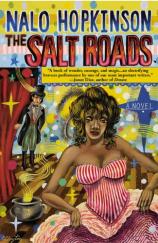Reading Group Guide
Discussion Questions
The Salt Roads

1. Makandal and Mer each have a different way of dealing with the oppression that their people face. They represent different voices in a larger argument about how best to take action to liberate a group of people from domination. How would you define the differences in their beliefs? What do you think is the best course of action?
2. Near the end of the novel, Jeanne Duval makes herself appear more haggard, aged, and decrepit than she is when she walks past her old lover Nadar. Why do you think she does this?
3. From Jeanne Duval's relationship with Baudelaire to Mer's relationship with Tipingee to Meritet's relationship with Judah, there are many kinds of love and friendship. How many types of significant relationships can you identify in the novel? What is the novel's ultimate view of love between men and women? Between women and women? What place does sex hold in the various relationships in this novel?
4. The Salt Roads uses the fantastical elements throughout the story: Makandal's shape-changing; Mer's visitation from Ezili; Meritet's super-real sensory abilities in the desert. What purpose do you feel it serves in a story to have a plot device, element, artifact, or image that isn't literally true or real? Do you see The Salt Roads as a "fantasy" novel?
5. Deities or lwas play a key role in this novel. How do they impact the events of this novel? How do they affect the lives of the individual people?
6. One reviewer said, "The essential beauty of The Salt Roads: history and folklore work together to provide a destiny for its characters, yet personal choice remains." How much choice do the characters of the novel have? How do their choices affect them?
7. The author incorporates real people and events from history in her novel (e.g., Charles Baudelaire, Jeanne Duval, Makandal and the revolution in Haiti), but imagines a possible scenario for how those people lived and how those events took place. How does the presence of these historical elements affect your reading of the novel?
8. Do you consider yourself the audience for this novel? Why or why not? Does being a member of the cultural group which most dominates a novel necessarily make a person more likely to appreciate or "get" that book?
9. Salt, an essential mineral for life, appears in this novel in many ways and has many features. Can you name how many times it is discussed? What meaning does it have? And what value-is it good or bad?
10. Fiction is about the problems and challenges that people face in their lives. Which characters in the novel have the most to lose? Which have the most to gain? How does the impact of slavery affect the white characters as well as the black characters? The mixed-race characters? How do class and money interact with the characters' racial and cultural backgrounds?
11. Fiction can use symbols and metaphors to link events together in a meaningful way. What are the most important symbols in the novel? What ideas and images stand out the strongest to you? What statements do you think they make? How many of them do you think were intentional on the author's part? Is it possible for authors to control how their work is understood? Is it desirable?
12. Much of what the author describes in this book involves suffering, but there were also many descriptions of triumph. What is the greatest tragedy of this novel? What is the greatest victory? What was your emotional response to this book? Did you find it depressing? Or uplifting?
The Salt Roads
- Publication Date: November 1, 2004
- Paperback: 416 pages
- Publisher: Grand Central Publishing
- ISBN-10: 0446677132
- ISBN-13: 9780446677134







